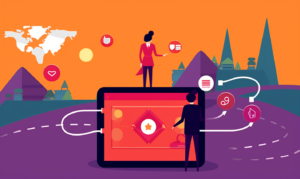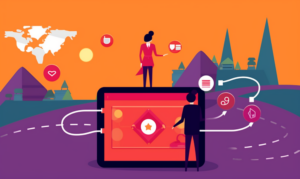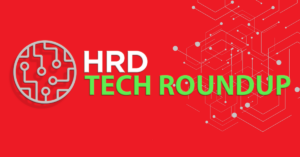HR software that fits your business needs
- 8 Min Read
There is a plethora of HR software vendors in the market that offer an array of features and tools, but for a company to make the right decision its important to never lose sight of its business needs are. To make that choice easier HRD Connect offers its insight into the aspects worth considering before buying.
- Author: Aaran Fronda
- Date published: Oct 23, 2018
- Categories

 A core objective of human resource management is to improve the overall performance of a company by empowering the people that work in it. A major challenge for HR professionals to overcome is the inherent state of flux that businesses exist in, whereby staff come and go, markets evolve, and every day is different to the last.
A core objective of human resource management is to improve the overall performance of a company by empowering the people that work in it. A major challenge for HR professionals to overcome is the inherent state of flux that businesses exist in, whereby staff come and go, markets evolve, and every day is different to the last.
Consequently, HR practices must remain fluid and capable of adapting to suit the needs of a business over time and those that are rigid will inevitably see cracks form. In an ever-evolving environment, however, it can be difficult to measure outcomes, but there are three common categories that HR professionals tend to use for gauging the effectiveness of the practices and processes they implement: financial, talent acquisition and employee engagement.
The first goes against how most HR professionals tend to want to view the employees under their care – as numbers on a spreadsheet rather than valued members of the team. But good HR management demands that employees be viewed in this manner to help a company plan and make strategic hires when necessary and, when needed, make cutbacks. HR professionals must analyse the value of each employee against their cost to the business to make accurate assessments that lead to correct decisions.
Talent acquisition relates to the recruitment practices used by HR professionals to help find people capable of fuelling the business to meet its goals and wider growth plans. This requires HR managers to consider the overall method for and, cost of, finding and acquiring new staff, along with keeping an eye on things like offer acceptance ratio to determine how attractive the company’s brand is to prospective candidates and how competitive its renumeration packages are compared to market rivals.
Lastly, it is essential that HR departments are capable of measuring employee satisfaction, engagement and development. If staff turnover is too high, or employees exhibit a high degree of dissatisfaction and absenteeism it is likely that not enough is being done to keep employees adequately challenged and fulfilled to retain top talent.
To assist HR professionals in developing cohesive practices and effectively measure performance across these three key categories there are various human resource management systems (HRMS) to choose from. These providers offer everything from core HR tools, such as talent acquisition and human resource management software to staff development and engagement functions. They tend to also offer additional modular products that can perform more specific functions to help tailor HR systems to meet the individual needs of a company. The dexterity of modern HR software is perfect for a department where fluidity and flexibility are key to success, but with so much functionality and features to choose from it is difficult to decide which HRMS product is the best fit.
Pick and mix
Many of the major and most-used vendors like Oracle, SAP, and ADP offer a similar set of core HR tools to their customers. These help HR management teams to collate and collect data on things like payroll, employee benefits, vacation and sick days with greater efficiency. For larger, multinational companies that require a more comprehensive set of basic HR tools, including adequate compliance monitoring and payroll services that work on a global scale, all the majors along with vendors like Workday, Ultimate Software and SuccessFactors are all worth considering not only because their software is highly sophisticated, but its solutions are applicable and compliant with employment laws in multiple jurisdictions.
In the current job market, where demand outstrips supply, most companies don’t struggle in acquiring new talent, but all companies worry about how best to retain their top workers from leaving for greener pastures. For companies interested in talent management software tools to help to cultivate HR practices that serve to create employee development programs that will keep staff engaged and deliver training to help them reach their full potential at the company there are a lot of programs to choose from. But before pulling the trigger and signing up for a subscription it is work considering how the software will fit around pre-existing talent management systems or in the development of them in smaller fledgling companies. For example, smaller enterprises that are looking for something simple should consider using vendors that offer software-as-a-service (SaaS) solutions offered by vendors like Cornerstone. Using a SaaS system keeps things cheap and simple. This is because companies can access the software via a web browser or app with the vendor often on-hand to provide on-demand assistance and regular software maintenance and updates, reducing a business’ IT expenditure.
No matter what software program a company chooses, one of the most important factors to consider is its compatibility and ease of integration with existing IT systems. This issue is less of a concern for smaller companies, but for older, larger businesses with often antiquated legacy systems it poses a major challenge worth addressing. Luckily, the recent rise of the application programming interface (API) offers companies cloud-based solutions that allow them to tap into all the HR functionality they need, while being agile enough for legacy systems to seamlessly connect with new HR software via these same APIs.
HR in action
Human resource information systems (HRIS) are instrumental in helping HR professionals standardise employees data so they can implement HR practices that help bring the wider needs of the business and the desires of the individuals that comprise it in a manner that ensures both are satisfied. When these HR systems are formulated correctly it can lead to some incredible results – something that car manufacturer Nissan saw after embarked on a major overhaul of its HRIS after integrating new software solutions to align its employees with the core values and ambitions of the company.
Back in 1999, Japan-based Nissan agreed a strategic partnership with France-based rival Renault. The alliance helped both companies benefit from increased economies of scale, accelerating the car manufacturers time to market. Over the decade that followed the two companies grew rapidly both in terms of geographical footprint and the number of staff they employed. In fact, by 2010 the two companies jointly employed around 130,000 worldwide. It was at this point that management decided that a coordinated approach was required, and a harmonising of the two companies HR practices was necessary. The then CEO of Nissan, Carlos Ghosn opted to introduce a new HR system which not only automated many HR practices across the alliance but strengthened its management of its employees across both companies. According to Ritu Guptu and Dr. Pratyush Banerjee’s report on Nissan’s new era in HR management, by standardising the HR practices of both companies it was able to not only reduce overall costs but improved the way the two manufacturers operated on a day-to-day basis.
Despite having a company intranet, it was not very appealing to many of the its employees, but worse still was the fact that most staff simply did not have adequate access to it. But by implementing a new intranet portal, effectively creating a one-stop shop for all HR related content, it led to some positive outcomes with the new portal, employees were far more engaged with the company and were able to fill important HR forms out online, freeing up the human resources team to focus on more pressing matters. To implement its new HRIS Nissan partnered with Enwisen and Oracle’s PeopleSoft application. The former was charged with the creation of the company’s human capital management system and employee portal, while the latter provided communication and strategic support for the alliance.
It’s important to note that not all HR system revamps are quite as successful as Nissan’s. When the Canadian government chose to overhaul their payroll system, it enrolled the services of Oracle and its PeopleSoft application software. What was initially meant to ensure government employees received their paycheques in a more efficient manner, ended up a complete disaster, with more than 80,000 people either receiving the wrong amount in their bank account or some cases not getting paid at all. However, the fault did not lie with Oracle’s software. During that time, the government had embarked on several cost-cutting measures which saw the size of its internal IT department cut significantly.
Meaning that despite the government investing in cutting-edge software, without the necessary number of HR professionals wielding it, errors naturally occurred. The lesson to learn from this example is that no matter how many new and innovative HR software programs there are, success is never guaranteed. In the end, if new HR systems are not implemented by knowledgeable HR professionals with an understanding of both the company’s business goals and those of its staff, it will likely lead to more missteps than greater synergies.








